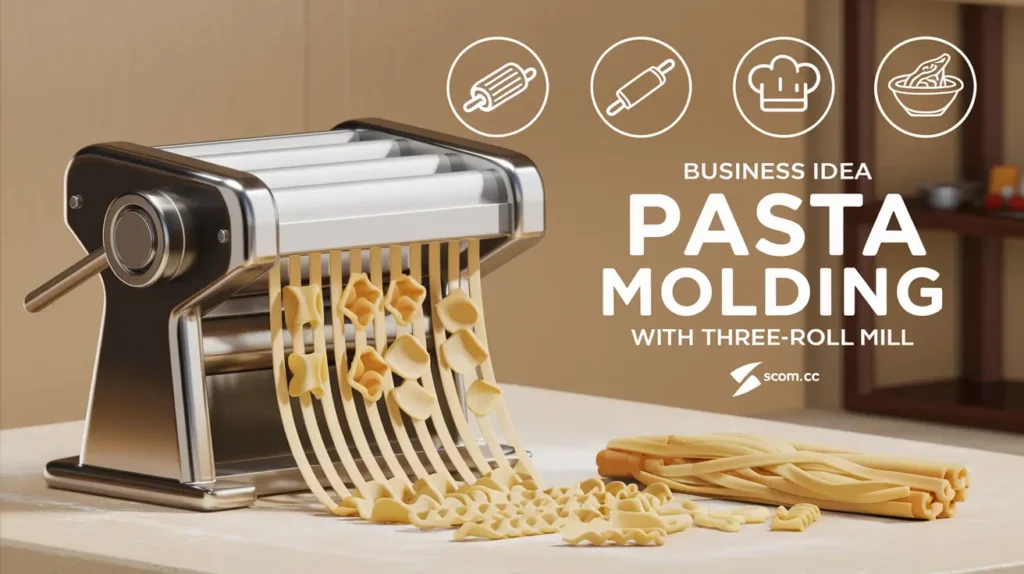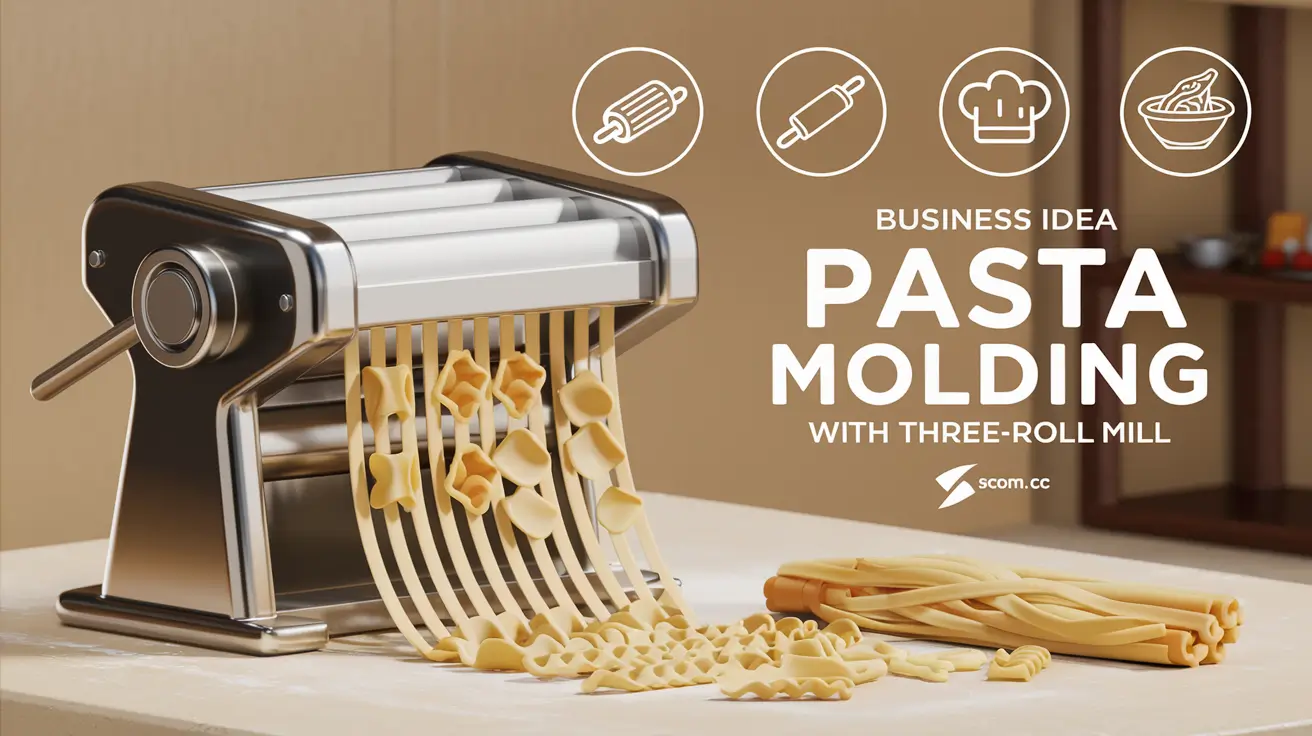Business Idea Pasta Molding with Three-Roll Mill

- Business Idea Pasta Molding with Three-Roll Mill
- Introduction to Pasta Molding with a Three-Roll Mill
- What Is a Three-Roll Mill?
- Market Potential for Pasta Molding Services
- Initial Costs and Investment
- Benefits of Using a Three-Roll Mill for Pasta Molding
- Challenges and Considerations
- Legal and Regulatory Aspects
- Marketing and Placement Strategies
- Future Trends and Innovations
- Conclusion
- Summary Table
-
FAQ
- What is a three-roll mill?
- What are the initial costs for starting a pasta molding business with a three-roll mill?
- What are the main benefits of using a three-roll mill for pasta molding?
- What challenges might businesses face with pasta molding using a three-roll mill?
- What legal and regulatory aspects should be considered?
- How can businesses effectively market their pasta molding services?
- What are the future trends in pasta molding?
Business Idea Pasta Molding with Three-Roll Mill
Pasta Molding with a Three-Roll Mill: Enhancing Pasta Production Efficiency
Offer pasta molding services using a three-roll mill, ideal for high-demand food product manufacturers.
Introduction to Pasta Molding with a Three-Roll Mill
Pasta molding is a crucial process in the production of pasta, ensuring that the pasta maintains its shape and texture. The use of a three-roll mill for pasta molding offers a refined approach to achieving consistent quality and efficiency in pasta production. This guide explores the concept of pasta molding using a three-roll mill, its market potential, benefits, initial costs, and key considerations for establishing a successful business.
What Is a Three-Roll Mill?
A three-roll mill is a type of mechanical device used in various industries for processing and molding materials. In pasta production, this mill is utilized to mold pasta dough into specific shapes and ensure uniformity.
How It Works
- Roll Configuration: Consists of three horizontally aligned rollers with varying gaps between them.
- Molding Process: The pasta dough is fed through the rollers, which apply pressure to shape and compress the dough.
- Uniformity: Ensures consistent thickness and texture of the pasta.
Key Features
- Adjustable Gaps: Allows for control over the thickness of the pasta.
- High Precision: Provides accurate molding for consistent product quality.
- Versatility: Suitable for a variety of pasta shapes and sizes.
Market Potential for Pasta Molding Services
The demand for high-quality pasta is strong in both the consumer and commercial markets. As food manufacturers seek to optimize their production processes, pasta molding services using a three-roll mill can cater to this need, providing consistent and efficient pasta production.
Target Markets
- Food Product Manufacturers: Companies that produce pasta and other similar food products.
- Restaurants and Food Service Providers: Establishments that require customized pasta shapes and sizes.
- Gourmet and Artisanal Pasta Producers: Businesses focused on high-end and unique pasta products.
- Retail and Wholesale Distributors: Entities that distribute pasta to grocery stores and other retail outlets.
Initial Costs and Investment
Starting a pasta molding service using a three-roll mill involves several initial costs. These include the purchase of the mill, setup expenses, and ongoing operational costs.
Cost Breakdown
- Three-Roll Mill: The cost of a three-roll mill can range from $20,000 to $100,000, depending on its size and capabilities.
- Raw Materials: Costs for pasta ingredients, including flour, water, and any additional flavorings or additives.
- Facility Setup: Expenses for setting up the production facility, including space, utilities, and installation of the mill.
- Labor and Training: Costs associated with hiring and training staff to operate the mill and manage the production process.
Benefits of Using a Three-Roll Mill for Pasta Molding
Utilizing a three-roll mill for pasta molding offers several advantages, particularly in terms of production efficiency, consistency, and quality. These benefits make it an attractive option for pasta manufacturers.
Advantages
- Consistent Quality: Ensures uniform thickness and texture, resulting in high-quality pasta.
- Increased Efficiency: Streamlines the molding process, reducing production time and labor costs.
- Versatility: Capable of producing various pasta shapes and sizes to meet different market demands.
- Reduced Waste: Minimizes dough waste by providing precise control over the molding process.
Challenges and Considerations
While the use of a three-roll mill offers significant benefits, there are challenges and considerations that businesses must address to ensure successful operation.
Common Challenges
- High Initial Investment: The cost of purchasing and installing a three-roll mill can be substantial.
- Maintenance Costs: Ongoing maintenance and repair costs for the mill and associated equipment.
- Training Requirements: Need for skilled operators who are trained in using the three-roll mill effectively.
- Market Competition: Competition from other pasta producers and manufacturers who may have established processes.
Legal and Regulatory Aspects
Operating a pasta molding business requires compliance with various legal and regulatory standards. Adhering to these requirements is essential for maintaining product quality and ensuring consumer safety.
Key Regulations
- Food Safety Standards: Compliance with food safety regulations, including hygiene and sanitation practices.
- Labeling Requirements: Accurate labeling of ingredients, nutritional information, and allergen warnings.
- Health and Safety: Ensuring that workplace safety standards are met for employees involved in the production process.
- Environmental Regulations: Adherence to regulations related to waste management and emissions.
Marketing and Placement Strategies
Effective marketing and placement strategies are crucial for promoting pasta molding services and attracting potential clients. Building a strong market presence can enhance visibility and drive business growth.
Marketing Tips
- Showcase Capabilities: Highlight the features and benefits of using a three-roll mill for pasta molding.
- Target Specific Markets: Focus marketing efforts on food manufacturers, restaurants, and gourmet producers.
- Develop a Strong Brand: Create a professional brand image and online presence to attract clients.
- Leverage Industry Networks: Engage with industry associations and networks to build connections and gain referrals.
Future Trends and Innovations
The pasta molding industry is evolving with new trends and innovations. Staying informed about these developments can provide a competitive edge and help businesses adapt to changing market demands.
Emerging Trends
- Health-Conscious Products: Increased demand for healthier pasta options, including whole grain and gluten-free varieties.
- Automation and Technology: Integration of automation and digital tools for improved production efficiency and precision.
- Customization and Personalisation: Growing interest in customized pasta shapes and flavors to meet specific consumer preferences.
- Sustainability: Adoption of sustainable practices and materials in pasta production.
Conclusion
Pasta molding using a three-roll mill offers a valuable opportunity to enhance the production of high-quality pasta products. By understanding the market potential, managing initial costs, and addressing challenges, businesses can successfully establish and grow their pasta molding operations. With a focus on innovation, efficiency, and effective marketing, this business model can meet the increasing demand for premium pasta in the food industry.
Summary Table
| Aspect | Details |
|---|---|
| Service | Pasta molding using a three-roll mill |
| Key Features | Consistent quality, increased efficiency, versatility, reduced waste |
| Target Markets | Food product manufacturers, restaurants, gourmet producers, retail distributors |
| Initial Costs | $20,000 to $100,000 for machinery, plus raw materials, facility setup, and labor expenses |
| Benefits | Consistent quality, increased efficiency, versatility, reduced waste |
| Challenges | High initial investment, maintenance costs, training requirements, market competition |
| Legal Requirements | Food safety standards, labeling requirements, health and safety, environmental regulations |
| Marketing Strategies | Showcase capabilities, target specific markets, develop a strong brand, leverage industry networks |
| Future Trends | Health-conscious products, automation and technology, customization, sustainability |
FAQ
What is a three-roll mill?
A three-roll mill is a mechanical device used for processing and molding materials. In pasta production, it shapes and compresses pasta dough to ensure uniform thickness and texture.
What are the initial costs for starting a pasta molding business with a three-roll mill?
Initial costs include $20,000 to $100,000 for the mill, plus expenses for raw materials, facility setup, and labor.
What are the main benefits of using a three-roll mill for pasta molding?
Benefits include consistent quality, increased production efficiency, versatility in pasta shapes and sizes, and reduced waste.
What challenges might businesses face with pasta molding using a three-roll mill?
Challenges include high initial investment, maintenance costs, the need for skilled operators, and market competition.
What legal and regulatory aspects should be considered?
Businesses must comply with food safety standards, accurate labeling, health and safety regulations, and environmental regulations.
How can businesses effectively market their pasta molding services?
Effective marketing strategies include showcasing the capabilities of the three-roll mill, targeting specific markets, developing a strong brand, and leveraging industry networks.
What are the future trends in pasta molding?
Emerging trends include health-conscious products, automation and technology, customization and personalization, and sustainability in production practices.

If you enjoyed this article and found it valuable, we encourage you to explore our news and valuable information section, where you'll find more relevant and up-to-date content that may pique your interest. Additionally, if you are seeking advice or need guidance on a specific topic, we suggest visiting our services section. There, you will find a variety of options designed to assist and support you in addressing your needs. Feel free to check out both sections to get the information and assistance that best suits your requirements.

Leave a Reply